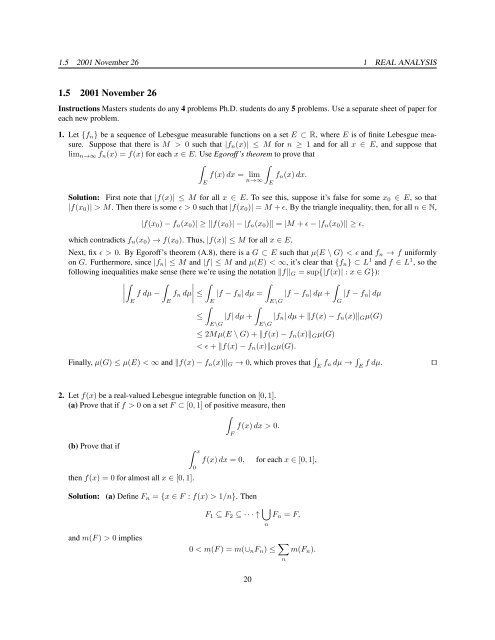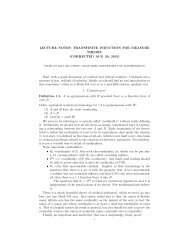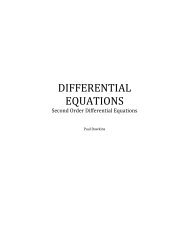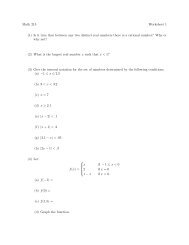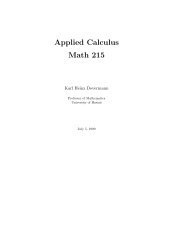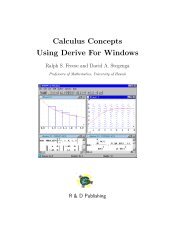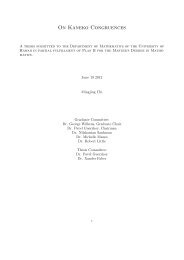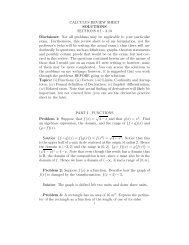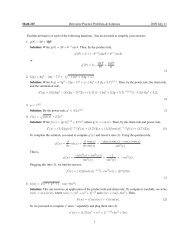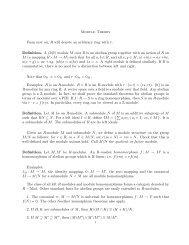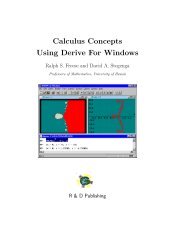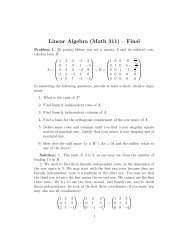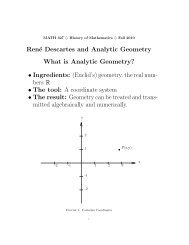Problems and Solutions in - Mathematics - University of Hawaii
Problems and Solutions in - Mathematics - University of Hawaii
Problems and Solutions in - Mathematics - University of Hawaii
You also want an ePaper? Increase the reach of your titles
YUMPU automatically turns print PDFs into web optimized ePapers that Google loves.
1.5 2001 November 26 1 REAL ANALYSIS<br />
1.5 2001 November 26<br />
Instructions Masters students do any 4 problems Ph.D. students do any 5 problems. Use a separate sheet <strong>of</strong> paper for<br />
each new problem.<br />
1. Let {fn} be a sequence <strong>of</strong> Lebesgue measurable functions on a set E ⊂ R, where E is <strong>of</strong> f<strong>in</strong>ite Lebesgue measure.<br />
Suppose that there is M > 0 such that |fn(x)| ≤ M for n ≥ 1 <strong>and</strong> for all x ∈ E, <strong>and</strong> suppose that<br />
limn→∞ fn(x) = f(x) for each x ∈ E. Use Egor<strong>of</strong>f’s theorem to prove that<br />
<br />
<br />
f(x) dx = lim fn(x) dx.<br />
n→∞<br />
E<br />
Solution: First note that |f(x)| ≤ M for all x ∈ E. To see this, suppose it’s false for some x0 ∈ E, so that<br />
|f(x0)| > M. Then there is some ɛ > 0 such that |f(x0)| = M + ɛ. By the triangle <strong>in</strong>equality, then, for all n ∈ N,<br />
|f(x0) − fn(x0)| ≥ ||f(x0)| − |fn(x0)|| = |M + ɛ − |fn(x0)|| ≥ ɛ,<br />
which contradicts fn(x0) → f(x0). Thus, |f(x)| ≤ M for all x ∈ E.<br />
Next, fix ɛ > 0. By Egor<strong>of</strong>f’s theorem (A.8), there is a G ⊂ E such that µ(E \ G) < ɛ <strong>and</strong> fn → f uniformly<br />
on G. Furthermore, s<strong>in</strong>ce |fn| ≤ M <strong>and</strong> |f| ≤ M <strong>and</strong> µ(E) < ∞, it’s clear that {fn} ⊂ L 1 <strong>and</strong> f ∈ L 1 , so the<br />
follow<strong>in</strong>g <strong>in</strong>equalities make sense (here we’re us<strong>in</strong>g the notation fG = sup{|f(x)| : x ∈ G}):<br />
<br />
<br />
<br />
<br />
<br />
f dµ − fn dµ <br />
<br />
E<br />
E<br />
≤<br />
<br />
<br />
<br />
|f − fn| dµ = |f − fn| dµ + |f − fn| dµ<br />
E<br />
E\G<br />
G<br />
<br />
<br />
≤ |f| dµ + |fn| dµ + f(x) − fn(x)Gµ(G)<br />
E\G<br />
E\G<br />
≤ 2Mµ(E \ G) + f(x) − fn(x)Gµ(G)<br />
< ɛ + f(x) − fn(x)Gµ(G).<br />
F<strong>in</strong>ally, µ(G) ≤ µ(E) < ∞ <strong>and</strong> f(x) − fn(x)G → 0, which proves that <br />
E fn dµ → <br />
2. Let f(x) be a real-valued Lebesgue <strong>in</strong>tegrable function on [0, 1].<br />
(a) Prove that if f > 0 on a set F ⊂ [0, 1] <strong>of</strong> positive measure, then<br />
<br />
f(x) dx > 0.<br />
(b) Prove that if x<br />
f(x) dx = 0, for each x ∈ [0, 1],<br />
then f(x) = 0 for almost all x ∈ [0, 1].<br />
Solution: (a) Def<strong>in</strong>e Fn = {x ∈ F : f(x) > 1/n}. Then<br />
<strong>and</strong> m(F ) > 0 implies<br />
0<br />
F<br />
F1 ⊆ F2 ⊆ · · · ↑ <br />
Fn = F,<br />
0 < m(F ) = m(∪nFn) ≤ <br />
m(Fn).<br />
20<br />
n<br />
E<br />
n<br />
E<br />
f dµ. ⊓⊔


